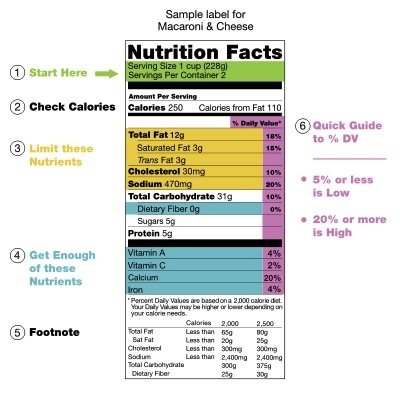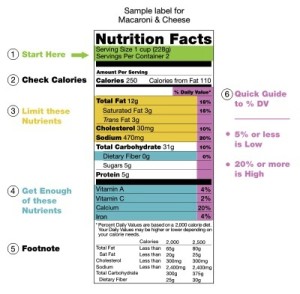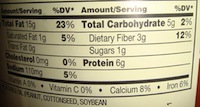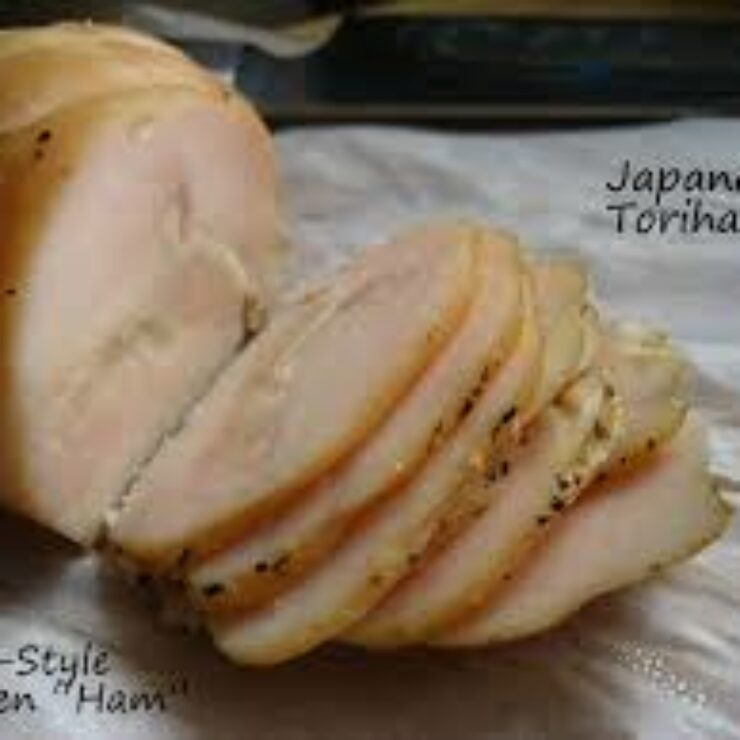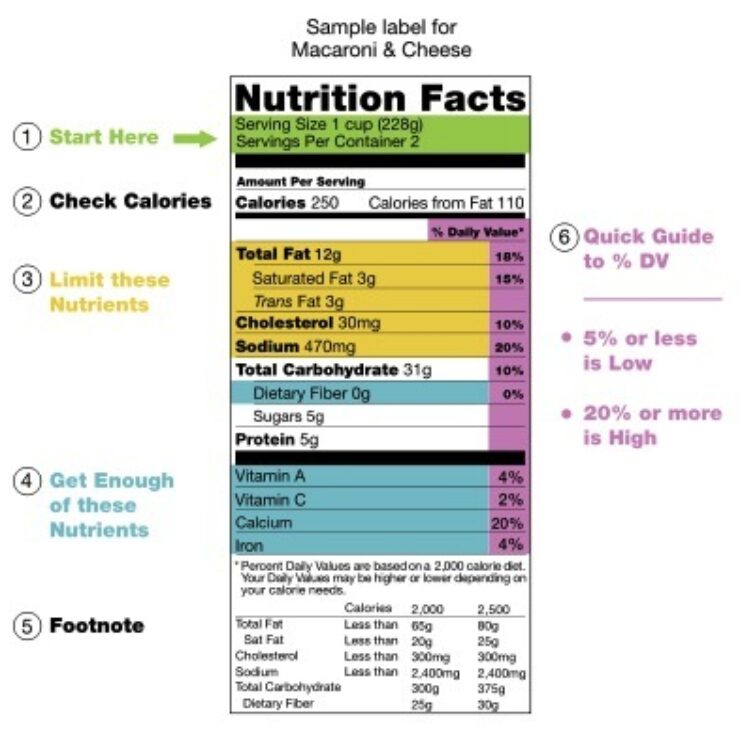Start here. Note the size of a single serving and how many servings are in the package.
Check total calories per serving. Look at the serving size and how many servings you’re really consuming. If you double the servings you eat, you double the calories and nutrients, including the Percent Daily Value (% DV).
Limit these nutrients. Remember, you need to limit your total fat to no more than 56–78 grams a day — including no more than 16 grams of saturated fat, less than two grams of trans fat, and less than 300 mg cholesterol (for a 2,000 calorie diet).
Get enough of these nutrients. Make sure you get 100 percent of the fiber, vitamins and other nutrients you need every day.
Quick guide to % DV. The % DV section tells you the percent of each nutrient in a single serving, in terms of the daily recommended amount. As a guide, if you want to consume less of a nutrient (such as saturated fat, cholesterol or sodium), choose foods with a lower % DV — 5 percent or less is low. If you want to consume more of a nutrient (such as fiber), seek foods with a higher % DV — 20 percent or more is high.
Eating clean simply means to cut out the “bad” from your daily menu. “Bad” meaning foods that contain medium to high fats, high sodium, high sugar and simple carbohydrates. Keeping it clean means to load up on fiber, vegetables, proteins and good fats, low sodium and complex carbohydrates. A good way to learn to eat clean is to not worry so much about what you shouldn’t eat and focus on what you should eat.
What does “sugars” mean in the Nutrition Facts panel? “Sugar” refers to the family of simple carbohydrates that are found naturally in fruits, vegetables, grains and dairy products and that are added to foods as sweeteners. Naturally occurring and added sugars are identical. Whether you eat a banana or a banana nut muffin your body cannot tell which sugars were present in the fruit and which were added by the baker.
Total Carbohydrates: Carbohydrates are good when they are the right kind. Look at the total numbers of carbohydrates. Carbohydrates are made up from two sources – Fiber and Sugar. Carbohydrates made up from fiber are good. These are the carbohydrates we want in our body. The more fiber the better. Fiber supplies us with vitamins and energy. Fiber is great for your digestive system and helps keep you full longer because its slow digesting. Eventually the fiber in your body is disposed out your digestive tract. The second source of carbohydrate is from sugar. Sugar has very little nutritional value. The sugars that are stored in your body eventually convert to fat. High sugar is related to many diseases, cancer and is the number one cause of diabetes. So it’s very important to keep the sugars low.
Look at your label. The idea is to take the total carbohydrate number and see what the fiber content is. You want the fiber to be high. You deduct the fiber number from the total carbohydrate number. The remaining number(s) should leave you within a close proximity to sugars left over. If the numbers don’t add up and there is still carbohydrates left after you deduct the fiber and sugar – those remaining are starches that haven’t been broken down. The following is an example:
You see this label breaks out TWO components of “total carbohydrates.” One is sugar, and one is fiber. The “countable” carbs in these almonds is 2g per serving (5g total – 3g fiber).
Quick individuals will note that 1g sugar + 3g fiber does not equal 5g total carbs. That’s because starches are not broken out.
In addition to the Nutrition Facts label, a lot of foods today also come with nutrient content claims provided by the manufacturer. These claims are typically featured in ads for the foods or in the promotional copy on the food packages themselves. They are strictly defined by the FDA. The chart below provides some of the most commonly used nutrient content claims, along with a detailed description of what the claim means.
| If a food claims to be… | It means that one serving of the product contains… |
|---|---|
| Calorie free | Less than 5 calories |
| Sugar free | Less than 0.5 grams of sugar |
| Fat | |
|---|---|
| Fat free | Less than 0.5 grams of fat |
| Low fat | 3 grams of fat or less |
| Reduced fat or less fat | At least 25 percent less fat than the regular product |
| Low in saturated fat | 1 gram of saturated fat or less, with not more than 15 percent of the calories coming from saturated fat |
| Lean | Less than 10 grams of fat, 4.5 grams of saturated fat and 95 milligrams of cholesterol |
| Extra lean | Less than 5 grams of fat, 2 grams of saturated fat and 95 milligrams of cholesterol |
| Light (lite) | At least one-third fewer calories or no more than half the fat of the regular product, or no more than half the sodium of the regular product |
| Cholesterol | |
|---|---|
| Cholesterol free | Less than 2 milligrams of cholesterol and 2 grams (or less) of saturated fat |
| Low cholesterol | 20 or fewer milligrams of cholesterol and 2 grams or less of saturated fat |
| Reduced cholesterol | At least 25 percent less cholesterol than the regular product and 2 grams or less of saturated fat |
| Sodium | |
|---|---|
| Sodium free or no sodium | Less than 5 milligrams of sodium and no sodium chloride in ingredients |
| Very low sodium | 35 milligrams or less of sodium |
| Low sodium | 140 milligrams or less of sodium |
| Reduced or less sodium | At least 25 percent less sodium than the regular product |
| Fiber | |
|---|---|
| High fiber | 5 grams or more of fiber |
| Good source of fiber | 2.5 to 4.9 grams of fiber |
If you can’t remember the definitions of all of the terms, don’t worry. You can use these general guidelines instead:
- “Free” means a food has the least possible amount of the specified nutrient.
- “Very Low” and “Low” means the food has a little more than foods labeled “Free.”
- “Reduced” or “Less” mean the food has 25 percent less of a specific nutrient than the regular version of the food.

